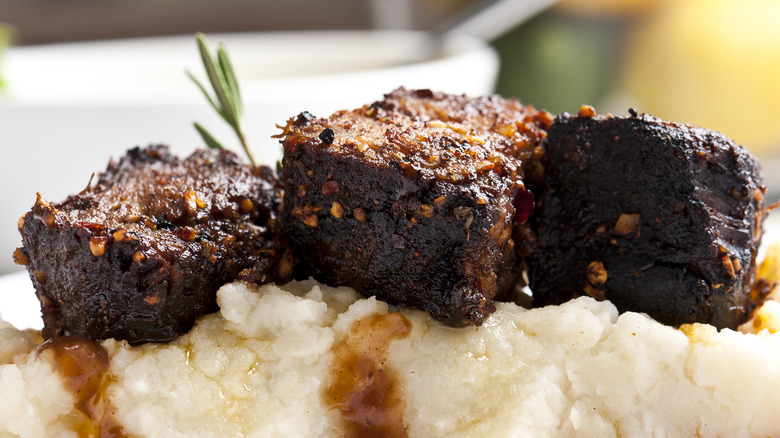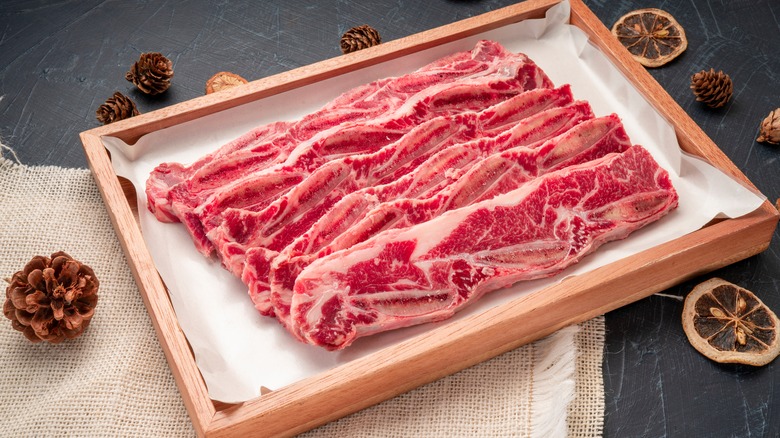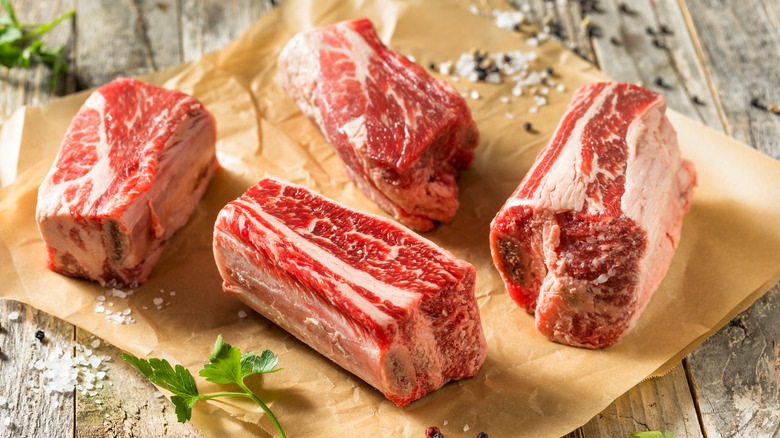When To Cook With Flanken Vs. English Cut Short Ribs
When it comes to bone-in cuts, it doesn't get much better than short ribs. These fatty, flavorful morsels of meat come from the lower section of the rib. Although they can be sourced across the length of the animal, the most lauded are from the chuck — meaning the front of the cow. These first five ribs are loaded with fat and meat, making them perfect candidates for a variety of preparations.
However, determining the best way to cook them depends on how they're butchered. There are two popular choices – flanken and English. In the former, the ribs are sliced into thin strips across the bone, with three or four pieces nestled into the cut. Then there's the English-style cut — the more popular short rib butchering in the U.S. The beef is sliced between the ribs, yielding meaty rib chunks, with one bone in the middle. Let's dive into when to cook with each.
Prepare flanken short ribs on high heat
In the U.S., flanken short ribs are most famously intertwined with Korean BBQ. Known as L.A.-style, these thin, half-inch cuts are mouth-wateringly delicious when sizzled on a hot grill. The high-fat content will likely drip and create flare-ups, adding palatable charred bites. Plus, those small sections of included bones will even out the heat distribution, lending a delicate texture.
While such a quick, high-heat method is the optimal way to bring out the cut's flavor, it does take some attention to detail. The thin cut, coupled with the abundant connective tissue, means that flanken ribs easily turn tough. Keep a close eye on the cooking duration, and marinate before cooking. While the cut won't yield an eye-catching medium-rare slice, it boasts a delicious beef taste, especially when elevated with a marinade.
Such a robust flavor makes flanken short ribs applicable in braising, too. In Jewish cooking, they're the base of a stew. The ribs are first seared for a couple of minutes on each side, then removed from the pan. Aromatics are then prepared in the beef juices, beef stock is poured in, and then the beef ribs are reintroduced. They're simmered for around three hours until tender.
English-cut short ribs are well suited to braising
Since the bone is front and center on English-cut short ribs, they're better suited for slow cooking. Braising will tenderize the cut's connective tissue and elevate the flavor. There's a range of slow-cooking recipes to choose from, including a hearty red wine take perfectly paired with potatoes or spiced-beer base that'll yield a delicious taco filling. No matter the method utilized, start by searing the ribs to create delicious flavor and contain juices. Then remove, add aromatics, and after some time on the pan, deglaze. Once the braising liquid is introduced, place the short ribs back into the cooking vessel, and braise for around three hours.
Braising isn't the only cooking option suitable for English-cut short ribs. When short ribs are cut thick, they can be seared on high heat to a medium rare consistency, highlighting their delicious beef flavor. Since the beef can get chewy, cut into smaller pieces, and serve alongside an accompaniment, rather than consuming like a steak. Juicy and flavorful, the preparation will showcase the delectable qualities of the English cut.


